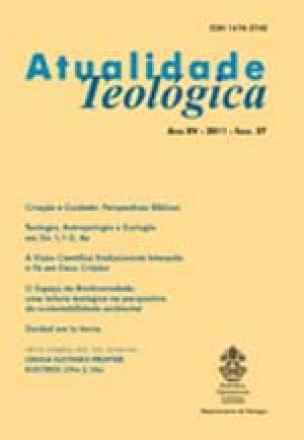A liberdade religiosa na Declaração Dignitatis humanae: elementos para uma nova teologia das religiões e para uma inserção da religião no espaço público
Atualidade Teológica
A liberdade religiosa na Declaração Dignitatis humanae: elementos para uma nova teologia das religiões e para uma inserção da religião no espaço público
Autor Correspondente: P. S. L. Gonçalves, A. B. Favretto | [email protected]
Palavras-chave: ConcÃlio Vaticano II, Declaração Dignitatis humanae, Liberdade religiosa, Dignidade da pessoa humana, Pluralismo religioso.
Resumos Cadastrados
Resumo Português:
Objetiva-se apresentar o processo de gênese e desenvolvimento do
tema da liberdade religiosa defi nido na Declaração Dignitatis humanae.
Esse tema não surge metodologicamente previsto pelos esquemas no ConcÃ-
lio Vaticano II, mas durante o processo de debates nas Congregações Gerais
e se desenvolvendo nos aspectos formais, signifi cado e fundamentação, e
material adquirindo status de Declaração. Metodologicamente, faz-se uma
análise fenomenológica que desemboca na hermenêutica histórica e teoló-
gica dos principais acontecimentos dos perÃodos conciliares preparatórios
e das quatro Sessões do ConcÃlio Vaticano II, bem como, de documentos
do Magistério eclesiástico dos séculos XIX e XX que abordaram o tema da
liberdade religiosa sob a perspectiva de intolerância à pluralidade religiosa
e tolerância religiosa prática, superadas pelo princÃpio de direito à liberdade
religiosa, expresso na Dignitatis humanae. Enquanto conteúdo doutrinal, o
direito a liberdade religiosa passa a ter fundamento na dignidade humana,
dado antropológico, que se desdobra do teológico e doutrinário e prospecta
uma nova compreensão do fenômeno do pluralismo religiosa possibilitando conceber a teologia das religiões como teologia do pluralismo religioso e
teologia hermenêutica inter-religiosa, bem como assegura a relevância das
religiões nos debates do espaço público, sendo este um direito tutelado e
promovido pelo Estado democrático.
Resumo Inglês:
The objective is to present the genesis process of the theme religious
liberty defi ned in the Declaration Dignitatis humanae. This topic does not
arise methodologically provided by schemes in the Vatican Council II, but
during the process of debates in the General Congregations and developing
itself in the formal aspects, meaning and foundation, and material acquiring
the status of the Declaration. Methodologically, it is a phenomenological
analysis that ends at the historical and theological hermeneutics of the
main events of the preparatory conciliates periods and the four Sessions
of the Vatican Council II, as well as, of documents of the Ecclesiastical
magisterium of the centuries XIX and XX, which approached the theme
of religious freedom from the perspective of religious plurality intolerance
and practical religious tolerance, overcome by the principle of the religious
freedom right, expressed in the Dignitatis humanae. As a doctrinal content,
the right to religious freedom gets onto the fundament of the human dignity,
anthropological data, which opens out to theological and doctrinaire and
prospect a new understanding of the phenomenon of religious plurality
enabling conceive the theology of the religions as theology of religious
pluralism and hermeneutic theology interfaith, as well as ensures the
relevance of religious in the public sphere debates, being this one a tutored
right and promoted by the democratic State

